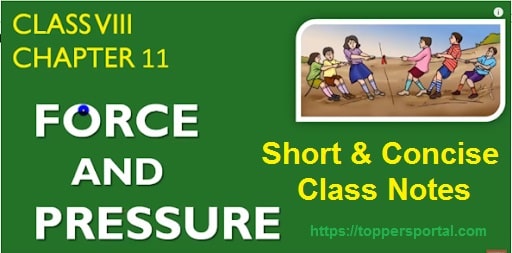Force and Pressure Class 8 Notes
The Force and Pressure Class 8 Notes Pdf Download link is at the bottom of the post. But you can go through the Force and Pressure Class 8 Notes without downloading the Pdf.
Firstly, let us see what we are going to study in this chapter. The overview of the chapter is very necessary for every student. This gives you an idea about the content we are going to study and can relate to our previous syllabus or chapters.
Let us first see what we are going to study-
- What is Force
- Effects of Forces
- Types of Forces: Contact Forces and Non-Contact Forces
- Muscular Force
- Gravitational Force
- Electrostatic Force
- Magnetic Force
- Frictional Force
- Types of Frictional Force
- Air Resistance
- What is Pressure
- Mathematical Formula of Pressure
- Pressure exerted by Liquids and Gases
- Atmospheric Pressure
Force and Pressure Class 8 Notes [Short and Concise]
What is Force?
In simple words, Force is a push or pull.
- Mathematically, Force = Mass × Acceleration
- The SI unit of Force is Newton. It is denoted by the symbol N (Capital ‘N’) after the name of Sir Issac Newton.
Effects of Forces
- Force can move an object or bring an object into a state of motion from the rest position.
- Force can stop an object or bring an object to rest from the state of motion
- Force can change the direction of an object
- Force can accelerate (speed up) or de-accelerate (slow down) an object
- Force can change the shape of an object
- Force can change the size of an object
Types of Forces
There are two types of forces-
- Contact Force
- Non-Contact Force
Contact Forces
The type of forces experienced by bodies when they are in direct contact with each other.
Examples:
- Muscular Force
- Frictional Force
- Normal Force
- Tension Force etc.
Non-Contact Forces
The type of forces that are able to push or pull even when the objects/bodies are not in physical or direct contact with each other.
Examples: The Forces that come under this category are-
- Electrostatic Force
- Gravitational Force
- Magnetic Force etc
Electrostatic Force
The force applied by a charged body on another charged or uncharged body is called electrostatic force.
Like Charges repel each other and Unlike charges attract each other.
- Like Charges: +ve and +ve or -ve and -ve
- Unlike Charges: +ve and -ve
Gravitational Force
It is the force of attraction that is acting between the objects in the universe.
Note: It is an attractive force.
What is Gravity?
It is the gravitational pull of the earth on the objects lying on or near the earth’s surface.
Magnetic Force
The force attraction or repulsion produced by magnets. When magnetic materials are brought in near a magnet it attracts the objects.
- Like Poles repel each other and Unlike Poles attract each other.
Muscular Force
The forces due to the action of our muscles is called Muscular force.
Frictional Force
What is Force of Friction (Frictional Force)?
It is the force that comes into action when the surfaces of two bodies come in contact with each other and it opposes the motion of the objects. It is not a fundamental force.
Types of Frictional Force
There are mainly two types of Frictional Forces-
- Static Friction
- Kinetic Friction (Sliding Friction & Rolling Friction)
Read About Frictional Force: Chapter 12 Friction
Pressure
Pressure acting on a body should never be confused with force. Force and pressure both are different quantities.
When a force acts on an area the effect changes.
We observe that a sharp knife easily cuts anything compared to a blunt knife, when the same amount of force is applied on both knives.
The reason is the pressure. Lets explore and try to understand the term pressure.
What is Pressure?
It is the thrust acting on the unit surface of an area.
Mathematically, Pressure = Force/Area
The SI Unit of pressure is N/m² or Pascal (denoted by Pa).
Define thrust.
The force acting in a particular direction (perpendicular).
Questioning: What is the SI Unit of pressure?
(A) N/m2
(B) Pascal
(C) Both A and B
(D) None of the Above
Comment your Answer Below
Pressure Exerted by Liquids
Important Points:
- pressure exerted by liquid increases with depth
- pressure exerted by the liquid is same in all directions at a given depth.
Manometer: It is an instrument used to measure the pressure difference
Atmospheric Pressure
The pressure exerted by the weight of the atmosphere on the earth’s surface.
The device used for measuring Atmospheric Pressure is called Barometer.
Important Unit Conversions
- 1 atm = 760 mmHg at sea level
- 1 atm = 101325 Pa.
Also Read: What is Atmosphere
I hope you loved these Force and Pressure Class 8 Notes. If you loved, do share with your friends these Force and Pressure Class 8 Notes.
